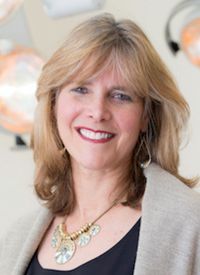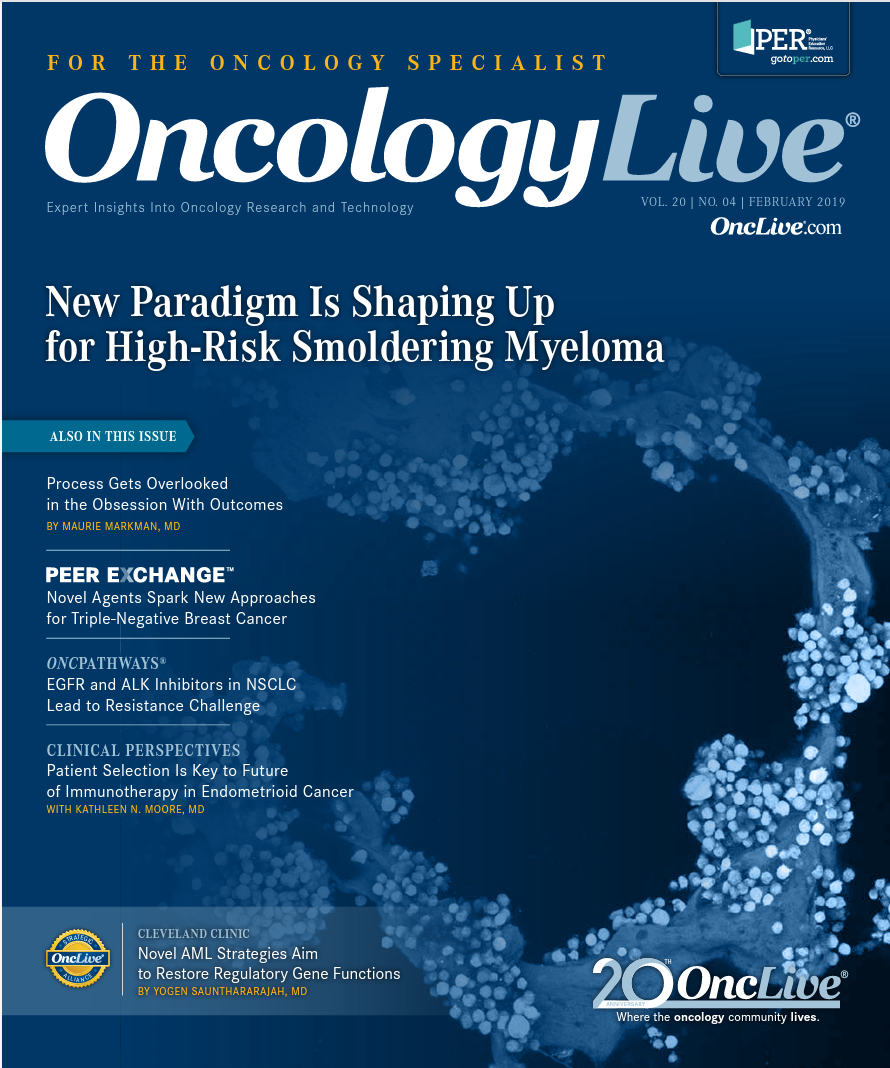Publication
Article
Oncology Live®
Esserman Helps Push Breast Cancer Prevention Beyond Routine Screenings
Author(s):
Laura J. Esserman, MD, MBA, a 2018 Giants of Cancer Care® award winner in the Cancer Diagnostics category led the way in designing the I-SPY clinical trials, a groundbreaking effort to match patients with breast cancer to potential therapies based on molecular drivers of disease. She also has advocated for a greater understanding of the biological drivers of breast cancer, rather than relying on mass screening programs, to better analyze early disease.
Laura J. Esserman, MD, MBA, associate professor of oncology and urology at Johns Hopkins Medicine

Laura J. Esserman, MD, MBA
Which had to go, the nipple or the status quo? Laura J. Esserman, MD, MBA, was discussing an upcoming mastectomy with a patient when the woman asked a simple question: “Why do you have to take the nipple?”
“Because if you don’t, it wouldn’t survive,” Esserman explained.
“Really?” the patient persisted. “How many times have you tried it? How do you know?”
That stopped Esserman cold—not an everyday occurrence for a woman routinely described as a visionary…a revolutionary…a force of nature.
Esserman, a professor of surgery and radiology at the University of California, San Francisco, and director of the UCSF Carol Franc Buck Breast Care Center, is best known for shredding the standards about breast cancer screening and treatment— even the definition of breast cancer itself. But she’s willing to take on any conventional wisdom if she thinks there is promise in the unconventional.
After that conversation in the early 2000s, Esserman learned more about the challenging, time-consuming, and the then almost unheard-of technique of skin-sparing mastectomy: removing the breast tissue but preserving the skin envelope and the nipple-areola complex. She and her team tried a series of surgical approaches until they figured out what worked. By 2007, it was their standard procedure.
That is, it was as much of a standard procedure as Esserman’s driving philosophy of change allows. She is not a believer in the one-size-fits-all approach, be it surgical techniques, mammography screening, or treatment protocols. A breast cancer surgeon who routinely calls for less surgery in favor of active surveillance of low-risk patients, she is a standard-bearer in the field of personalized and individualized medicine—and she is willing to take the heat for it.
No Stranger to Controversy
“You have to learn most from what does not work,” Esserman said. “First, you understand what went wrong and why and then move on. Keep trying.”Esserman has never been a stranger to controversy, from her passionate call for the Equal Rights Amendment in her high school graduation speech (“I got a lot of flak for that,” she said, laughing) to a 2009 JAMA piece she coauthored with a prostate cancer specialist that argued that the benefit of breast and prostate screening came at the cost of overdiagnosis and overtreatment.
They did not propose an end to screening but pointed out that it increases detection of slow-growing tumors, many of which are not life-threatening, and misses more aggressive ones. They even suggested that the lowest-risk cancers not be labeled cancer at all, but rather indolent lesions of epithelial origin, or IDLES. Many ductal carcinoma in situ (DCIS), found in the milk ducts of the breast and classified as noninvasive, or stage 0 breast cancer, may never be destined to become cancer.
“DCIS is, in many ways, a disease we created because of screening,” Esserman said. “Cancer is a serious disease, but we have to redefine what cancer truly is.”
Wisdom Study
Try telling the 60,000 women diagnosed with DCIS in the United States each year, many of whom undergo lumpectomies, radiation, or even mastectomies, that they don’t actually have cancer. Initially, the hate mail—“scathing things,” according to Esserman—poured in from women who felt she had invalidated their experience, as well as from physicians against change. But now her inbox is full of messages from patients seeking less-intensive intervention and clinicians looking for better data and approaches.Esserman showed that ultra low-risk cancers can be molecularly defined. Now she is taking it one step further with her WISDOM study, an adaptive, randomized clinical trial that looks at a woman’s individual risk factors—age, race, family history, breast density, genetics—and uses risk profiles to identify when women should receive annual or biennial mammograms, or no screening until age 50. Women found to be at the highest risk undergo an annual mammogram and magnetic resonance screening.
This personalized screening model could reduce the high rate of false positives (61% of women screened annually, according to a 2011 study of nearly 170,000 women in their 40s and 50s) and the anxiety and potentially unnecessary treatments they incur and, perhaps, promote prevention for those at highest risk.
“Some cancers are never destined to kill you, and some are rapidly growing and are destined to kill you,” Esserman said. “The WISDOM study is allowing us to ask who is at risk for what kind of tumor and how can we tailor screening to maximize benefit and minimize harm.”
For decades, women heard a single and very simple message: Early detection saves lives. “It turns out it’s just a more complicated story than that,” Esserman said.
Her eureka moment came during a medical conference at which a colon cancer specialist talked about the dramatic impact regular screening had on reducing the rates of full-blown disease. But that wasn’t happening in breast cancer, she realized. “This is not working,” she thought. “We’ve got it wrong here, and it’s not about the tumor stage. Every tumor isn’t the same. Biology has more to do with outcome than stage. Different types of tumors need to be treated differently. We just cannot be treating people as if all tumors are the same.”
Shortly after the publication of her 2009 JAMA article questioning the value of blanket screening beginning at age 40, the US Preventive Services Task Force issued new guidelines recommending that most women wait until age 50 to start regular breast cancer screening and that biennial examinations for women aged 50 to 74 years best balanced the benefits and harms of screening.
The American College of Radiology and the Society of Breast Imaging still recommend annual screening beginning at age 40, but in 2015, the American Cancer Society, a fervent believer in early detection, also changed its guidelines, recommending mammograms for women of average risk for cancer beginning at age 45 instead of 40, as well as biennial screenings for women 55 and older.
Early Years
“When you see something that you think isn’t right, even if it might cost you personally, you have to be willing to stand up and speak about it,” Esserman said. “Be optimistic. Be collaborative. Be unafraid, and be passionate about what you do. And always be an advocate for your patients, not your specialty.”Born in Chicago, Illinois, Esserman grew up in Miami, Florida, the daughter of an auto dealer and a teacher. Her childhood hero was Marie Curie. “Immunity, infections, cancer—those were always things that really interested me, even when I was kid. And what stuck with me was her passion and her devotion to her work, and I loved the fact that she was a woman and she had succeeded and made such a difference.”
Esserman has been willing to go to unusual lengths to help her patients—including singing her patients to sleep. She was in the operating room waiting for the anesthesiologist to arrive, and she could see her patient’s blood pressure climbing as the minutes dragged on. Suddenly, Esserman, a lifelong theater lover, found herself singing “All I Ask of You” from The Phantom of the Opera: “No more talk of darkness/Forget these wide-eyed fears/I’m here, nothing can harm you/ My words will warm and calm you.”
The Economics of Healthcare
They did—the patient’s systolic blood pressure dropped 40 points—and it’s a tradition she keeps up to this day. She even takes requests, including show tunes, pop songs, and arias, although the latter require more advance notice. Two years ago she started taking lessons with a voice coach and performing—outside the operating room, that is.Esserman did her surgical residency at Stanford University, and in 1991, her career took an unexpected turn. During grand rounds with Alain Enthoven, PhD, MPhil, the influential Stanford healthcare economist, she asked who would train the next generation of medical students. He told her to become a Hartford Fellow at Stanford Graduate School of Business and figure it out for herself.
At the time, Esserman was expecting her first child, Marisa, with her husband, Michael Endicott, and thought the idea was, in a word, “crazy.” But a consummate multitasker, she also was intrigued. Enthoven stepped up his recruitment efforts, and finally she applied.
Best Outcomes With Less Toxicity
Because she needed to keep up her surgical hours, she warned her professors that she might be late to class. For 1 particular class, she turned up on time just once—on the last day, no less—and earned a standing ovation from her fellow students.Although it would be a stretch to say that everything Esserman knows about healthcare she learned in business school, it was “absolutely transformative for me,” she said. Change management, organizational behavior, accelerating the pace of learning, even accounting—all helped her see she needed to change the way we practice medicine to learn better and faster, and how she could do it.
What she learned led to the I-SPY trial, which looked at women with stage II and III breast cancer receiving neoadjuvant therapy and allowed physicians to assess the impact of treatment on a tumor, giving rapid insight into which drugs work and which ones fail.
In the follow-up, I-SPY 2, patients with breast cancer undergoing neoadjuvant therapy received drugs targeted to the specific molecular profile of their tumors, with the goal of reducing drug development cost, speeding up the process of screening drugs, and bringing more effective drugs to the market faster. It has become a model for the development of drugs for other cancers, as well as Alzheimer disease.
“We have a great opportunity here to build systems that help us learn better,” Esserman said. “We, as physicians, have an obligation to improve healthcare value, to get the best outcomes with less toxicity—less emotional toxicity, less physical toxicity, less financial toxicity.”
Her ideal day? “In the clinic, when I see patients who started with terrible cancer and the tumors are gone, they can have less surgery and get their life back. And people who come in and have DCIS and don’t want to have surgery and are excited to find out there’s a new option. Meeting with the executive team with I-SPY or WISDOM and coming up with a new idea. And I can go home and sing at midnight.”
























%20(2)%201-Recovered-Recovered-Recovered-Recovered-Recovered-Recovered-Recovered-Recovered-Recovered-Recovered-Recovered-Recovered-Recovered-Recovered-Recovered-Recovered-Recovered.jpg?fit=crop&auto=format)
%20(2)%201-Recovered-Recovered-Recovered-Recovered-Recovered-Recovered-Recovered-Recovered-Recovered-Recovered-Recovered-Recovered-Recovered-Recovered-Recovered-Recovered-Recovered.jpg?fit=crop&auto=format)
